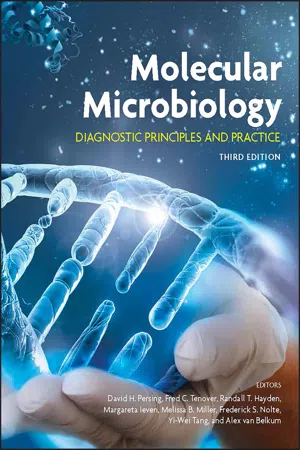
Molecular Microbiology
Diagnostic Principles and Practice
- English
- ePUB (mobile friendly)
- Available on iOS & Android
Molecular Microbiology
Diagnostic Principles and Practice
About this book
Presenting the latest molecular diagnostic techniques in one comprehensive volume
The molecular diagnostics landscape has changed dramatically since the last edition of Molecular Microbiology: Diagnostic Principles and Practice in 2011. With the spread of molecular testing and the development of new technologies and their opportunities, laboratory professionals and physicians more than ever need a resource to help them navigate this rapidly evolving field.
Editors David Persing and Fred Tenover have brought together a team of experienced researchers and diagnosticians to update this third edition comprehensively, to present the latest developments in molecular diagnostics in the support of clinical care and of basic and clinical research, including next-generation sequencing and whole-genome analysis. These updates are provided in an easy-to-read format and supported by a broad range of practical advice, such as determining the appropriate type and quantity of a specimen, releasing and concentrating the targets, and eliminating inhibitors.
Molecular Microbiology: Diagnostic Principles and Practice
- Presents the latest basic scientific theory underlying molecular diagnostics
- Offers tested and proven applications of molecular diagnostics for the diagnosis of infectious diseases, including point-of-care testing
- Illustrates and summarizes key concepts and techniques with detailed figures and tables
- Discusses emerging technologies, including the use of molecular typing methods for real-time tracking of infectious outbreaks and antibiotic resistance
- Advises on the latest quality control and quality assurance measures
- Explores the increasing opportunities and capabilities of information technology
Molecular Microbiology: Diagnostic Principles and Practice is a textbook for molecular diagnostics courses that can also be used by anyone involved with diagnostic test selection and interpretation. It is also a useful reference for laboratories and as a continuing education resource for physicians.
If you are looking for online access to the latest clinical microbiology content, please visit www.wiley.com/learn/clinmicronow.
Frequently asked questions
- Essential is ideal for learners and professionals who enjoy exploring a wide range of subjects. Access the Essential Library with 800,000+ trusted titles and best-sellers across business, personal growth, and the humanities. Includes unlimited reading time and Standard Read Aloud voice.
- Complete: Perfect for advanced learners and researchers needing full, unrestricted access. Unlock 1.4M+ books across hundreds of subjects, including academic and specialized titles. The Complete Plan also includes advanced features like Premium Read Aloud and Research Assistant.
Please note we cannot support devices running on iOS 13 and Android 7 or earlier. Learn more about using the app.
Information
INTRODUCTION AND GENERAL DISCUSSION
Pathophysiology of CNS Infections
Meningitis
Encephalitis
Classification of CNS Infections
Table of contents
- Cover Page
- Title Page
- Copyright Page
- Contents
- Contributors
- Preface
- Section I: Novel and Emerging Technologies
- Section II: Metagenomics: Implications for Diagnostics
- Section III: Health Care-Associated Infections
- Section IV: Molecular Diagnostics and Public Health
- Section V: Syndromic Diagnostics
- Section VI: Virology
- Section VII: Fungi and Protozoa
- Section VIII: Point-of-Care/Near-Care Diagnostics
- Section IX: The Host and Host Response
- Section X: Information Technology
- Section XI: Quality Assurance
- Section XII: The Business of Diagnostics
- Index